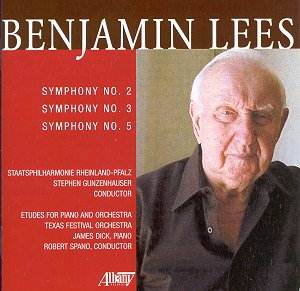Ever
since encountering one of Lees' works
on an LP I have wanted to know more.
In 1998 I reviewed the Fourth Symphony
on Naxos and now, some four years later,
this Albany set has emerged.
The
Second Symphony was a Louisville commission premiered by
them under their long-standing conductor, Robert Whitney on 3
December 1958. It is an athletic piece: flighty, not voluptuous,
its wings spread in monochrome. There is no superfluity of gesture
or texture but room is made for brassily mordant aggression in
the scherzo. The symphony follows a design of andante-scherzo-adagio.
It is not especially American or jazzy though some hints of
that appear in the scherzo. Use of side drum and percussion and
lyrical voicing paralleling Howard Hanson's Sixth Symphony (the
most 'modern' of the Hanson canon) are to be heard. This is without
the unembarrassed access of heroic melody associated with Hanson.
Lees writes in a style not at all tough like Carter or Sessions
but he is by no means an unbuttoned romantic. On the other hand
he is not as acerbic as Schuman. There are some chargingly truculent
Alwynisms in the adagio (5.08 tr. 3).
The
Third Symphony was premiered in Detroit on 16 January 1969
conducted by Sixten Ehrling. It is a work of three substantial
andante movements prefaced and separated by three Interludes
each no longer than two minutes. The Interludes feature the tenor
saxophone in one of those snake-strike explosions of sinuous lyric
energy. The first full movement is gesturally belligerent with
cliff-edge fortissimo melodramas from the brass while the second
has just as much voltage and velocity but skitters along quietly.
It is into quiet discontinuity that the final flickering and expansive
andante opens. Lees' penchant for impressionistic grand guignol
is in plentiful evidence here but something more emotionally momentous
rises impressively at 3.05 although at its peak ghosts seem to
float free and beckon.
The
half hour and single movement Fifth Symphony is divided
from the Third by the Fourth Symphony recorded on Naxos American
Classics 8.559002. The Fourth is Lees' very personal warning about
the Holocaust. The Fifth was premiered by the Delaware Symphony
Orchestra conducted by Stephen Gunzenhauser. Like the others it
is completely tonal, gritty, lucidly scored, seething with activity,
not inclined to long singing lines and certainly terse. The accelerating
trudge at 6.30 is rather like Panufnik in his few fast and furious
movements. The restless rhythmic figure that dominates much of
the work is remorseless. It is even picked up in the percussion
at 11.49 (Shostakovich 15's infernal clockwork?). The surging
tragic string writing at 20.09 belies my reference to the absence
of long singing lines. Here they feature in excoriatingly sharp
focus like the more serene writing for the violins in Vaughan
Williams' Fourth Symphony. The work rises to considerable and
magniloquent eminence with a strongly accented version of the
immanent rhythmic figure now transformed into sweeping majesty
and driven ever upward on the updraft of the brass choir. There
is something of Taras Bulba about this music but it is
superbly individual and confident. The performance will have you
leaping up to applaud. A superb work played with a rare passion.
Lees must have had his fears about this project. They were surely
dispelled quickly.
Lees
and his team must have been extremely pleased with his Rheinland-Pfalz
sessions. The results sound completely idiomatic.
Albany,
Karl Miller (whose open-handed generosity has greatly and enjoyably
expanded my knowledge of music) and Günter Appenheim abandon
the German orchestra for the Texas Festival Orchestra conducted
by Robert Spano. James Dick is piano soloist in the Etudes.
I know Dick's work from an impressive off-air tape of the unsung
Vincent Persichetti piano concerto. The Etudes (all five of them)
were premiered by the Houston Symphony conducted by Lawrence Foster
on 28 October 1974. The piece shares a nostalgic atmosphere with
the Third Symphony which makes sense because it dates from only
five years after that work. Parts of the work inhabit a louche
underworld - seeming to link with the back streets of Marseilles
as haunted by Constant Lambert and evoked in his Piano
Concerto and Elegiac Blues. There are incursions from William
Schuman's monolithic brass writing (Sixth and Seventh Symphonies)
- scorching and squat - in the last Etude. This is a live concert
recording captured complete with warmly appreciative applause.
It
is a pleasure to pay tribute to the bodies that supported this
heroically conceived and consummated project with grants: the
Aaron Copland Fund for Music, the Swedish Music Information Service
of the Swedish Consul General and the Alice M Ditson Fund of Columbia
University.
The
composer's notes touch lightly on the technicalities, describe
the passage of the music but deny us any knowledge of personal
allusion or inspiration. We must take the music as it stands.
I am afraid I am left no wiser about Kalmar Nyckel except that
a commemorative committee bearing his name commissioned the symphony.
(see below)
I
have been very pleased to make the acquaintance of these symphonies
(and the Etudes). The Fifth is a single span of some moment and
grandeur. I look forward to hearing more.
Rob
Barnett
"Kalmar Nyckel" is the name of the
ship that carried the first Swedish immigrants to what is now
Wilmington, Delaware.I hope this clears up the mystery.
Sincerely,
Benjamin Lees
